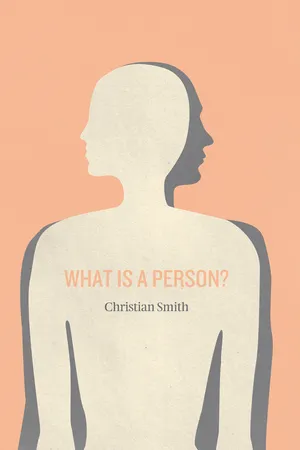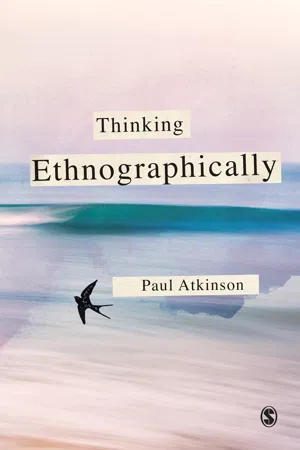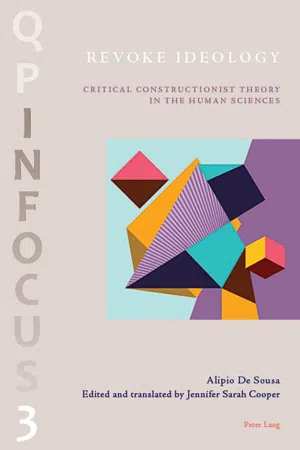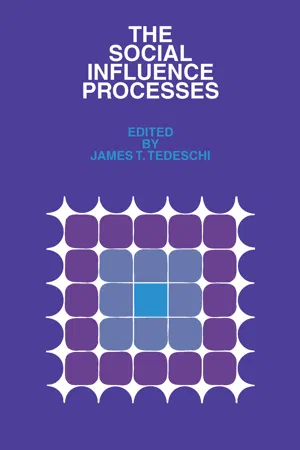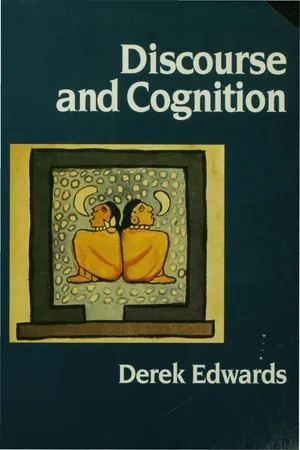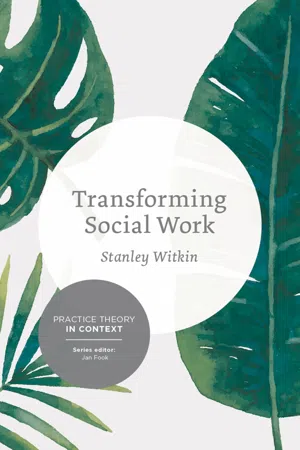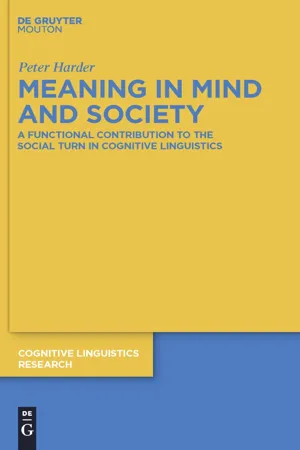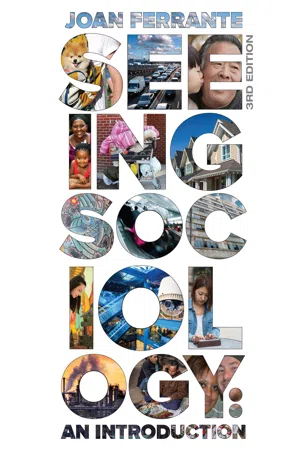Social Sciences
Construction of Social Reality
"Construction of Social Reality" is a concept introduced by philosopher John Searle, which explores how social institutions and systems are created and maintained through collective intentionality. Searle argues that these social realities, such as money, marriage, and government, exist as a result of shared beliefs and practices within a community. This concept highlights the role of human intentionality in shaping the social world.
Written by Perlego with AI-assistance
Related key terms
1 of 5
12 Key excerpts on "Construction of Social Reality"
- eBook - PDF
What Is a Person?
Rethinking Humanity, Social Life, and the Moral Good from the Person Up
- Christian Smith(Author)
- 2010(Publication Date)
- University of Chicago Press(Publisher)
Confusions and slippages of meaning are all too easy. To say, on the one hand, that humans construct reality (per se) is a grossly mislead-ing overstatement at best. To dismiss social constructions as not actually real, on the other hand, however, is also mistaken. Reality, it turns out, is more complicated than that. Reality contains both brute and institutional facts, mind-independent and dependent realities, existing objectively and subjectively in relation to human mental activities, which may or may not causally affect human experience, and about which humans may or may not even be aware. In some senses, all humans share the same (indepen-dently objective) reality. In other senses only people who belong to the same culture and participate in the same institutions share the same (de-pendently objective) reality. In yet other senses only realities that causally influence people are real in their lives. In yet other senses only realities about which people are aware are real “to them.” Much of this can vary at the level of civilizations, societies, cultures, regions, subcultures, clans, and families. We see, then, the need for greater precision in our social science analyses and communications when it comes to reality. All of this also provides us something of an agenda for social scientific research. If reality were simply a social construction then there would not be much for social science to do or say, since doing or saying much about that would merely erode the purpose and value of social science at least as normally conceived. But since reality is complex and not entirely a social construction, there is much work for social science to do. For we see that we have many relationships, contexts, situations, combinations, causal re-lations, processes, and outcomes to sort through. - eBook - ePub
- Paul Atkinson(Author)
- 2017(Publication Date)
- SAGE Publications Ltd(Publisher)
2 Defining Social Reality Introduction Social realities, social life-worlds, are what ethnographers study. They are not ‘given’ and they require detailed studies that reflect and respect their complexity. The notion that social realities are socially constructed is something of a commonplace. But it deserves careful attention. Constructionism (or constructivism) in general is a very important aspect of an ethnographic understanding. Unfortunately, it is readily misunderstood and poorly applied. In particular, it is too easy to assume that a constructionist analytic perspective implies that phenomena are ‘only’ constructed, or that they therefore lack any material substance. But there is nothing trivial about constructions, and they have real embodiments and practical accomplishment. Likewise, it is not the goal of constructionist analysis simply to conclude that things are socially constructed, but to document how they are, with what resources, and with what consequences. In other words, we ought to study how social realities are produced. Moreover, we need to remind ourselves that notions of construction always imply the social. We are not dealing here with private worlds or fantasies. Assumptions and activities in and about the world are generated through socially shared beliefs, knowledge and conventions. Consequently, there is a direct and necessary analytic parallel between our studies of social worlds and their production and the detailed study of practical knowledge. Just as realities are socially defined, so situations have their construction. The idea of the definition of the situation is fundamental to our close analysis of social activities and events. But if we subscribe to the view that situations are real insofar as they are defined as real, then that does not mean that any or all such defining is arbitrary. Far from it: such defining is based on shared or contested stocks of knowledge - eBook - PDF
Revoke Ideology
Critical Constructionist Theory in the Human Sciences
- Alipio DeSousa Filho, Jennifer Sarah Cooper(Authors)
- 2019(Publication Date)
- Peter Lang Group(Publisher)
Chapter 2 The Construction of Social Reality The form is fluid, but the “meaning” is even more so. — Nietzsche, On the Genealogy of Morals Meaning is not constituted except through structures of coercion of the signified. — Michel Foucault, What is Critique? … to say that a society functions is a truism, but to say that everything in a society functions is an absurdity. — Claude Lévi-Strauss, Structural Anthropology There will always be a distance between society as instituting and what is, at every moment, instituted – and this distance is not something negative or deficient; it is one of the expressions of the creative nature of history, what prevents it from fixing itself once and for all into the “finally found form” of social relations and of human activities, what makes a society always contain more than what it presents. To wish to abolish this distance, in one way or another, is not to leap from prehistory to history or from necessity to freedom, it is to wish to leap into the immediate absolute, that is to say into nothingness. — Cornelius Castoriadis, The Imaginary Institution of Society The social is arbitrary: Social reality is a construct, a convention One of the founders of sociology in the nineteenth century, Émile Durkheim, developed a theory that attributes characteristics of the social fact 1 that cor- 1 DURKHEIM, Émile. The Rules of the Sociological Method. Trans. W. D. Halls. New York: The Free Press, 1982. 64 Chapter 2 respond to the description of reality in general: exterior, objective, general, independent and coercive. This is also how reality is observed by those who are submitted to it. Clearly, in this sociological perspective, the Construction of Social Reality is indistinguishable from the process of its own institution- alization. In other words, mixed up with the process of its establishment, fixation, and reification of the space of society and its particular codes, stand- ards, values, beliefs, rules, moral definitions, etc. - eBook - PDF
The Literate Mind
A Study of Its Scope and Limitations
- Andy Wells(Author)
- 2017(Publication Date)
- Red Globe Press(Publisher)
28 Chapter 2 Social Construction and Independent Reality Many important insights into the nature of literacy have come from theo-rists and practitioners who consider it to be the result of processes of social construction. This chapter explores what it means to say that literacy is a social construction, and it enquires into the scope of the notion. Such an enquiry is particularly important in the context of this book because of its Darwinian perspective. A workable notion of social construction which is compatible with a Darwinian understanding of human life and its origins needs to be achieved in the context of theory which typically takes biologi-cal and social influences to be opposed. 2.1 The social construction of reality One of the most influential works in the social constructivist canon is The Social Construction of Reality by Peter Berger and Thomas Luckmann, published in 1966. Their perspective was sociological and they studied the nature of reality and knowledge, starting from the basic assumption that reality is different for different societies and is socially constructed. Sociologists, they said, had ‘systematic awareness of the fact that men in the street take quite different ‘realities’ for granted as between one society and another’ (Berger and Luckmann, 1966, p. 14). Is that right? Is it really a fact as they claim? Do people in different societies take quite different reali-ties for granted? It is important to note that the concept of multiple, differ-ent, realities is an assumption, not something demonstrated, and that one might with equal or greater plausibility argue that men in the street inter-pret a single reality in different ways from one society to another. There is clearly a marked difference between the two positions. I shall argue that the assumption of a single reality is altogether more coherent and more plausible, but for the present we can explore where the assumption of mul-tiple realities leads. - eBook - ePub
- James T. Tedeschi(Author)
- 2017(Publication Date)
- Routledge(Publisher)
IIThe Construction of Social Reality Jack M. McLeod and Steven R. ChaffeeWhy Social Reality?
Each of us likes to think of himself as being rational and autonomous. Our ideas seem to be peculiarly our own. It is hard for us to realize how little of our information comes from direct experience with the physical environment, and how much of it comes only indirectly, from other people and the mass media. Our complex communication systems enable us to overcome the time and space limitations that confined our ancestors, but they leave us with a greater dependence on others for shaping our ideas about how things are in the world. While becoming aware of places and events far from the direct experience of our daily lives, we have given up much of our capacity to confirm what we think we know.This dependence on communication would have little impact on the study of social influence processes were it not for certain other aspects of the way we typically construct our view of the world. First, it appears that much of the information obtained from others is given the status of reality, as if it were no less valid than if it had been a direct observation of physical reality. The personal and tentative nature of our information may be forgotten as the material becomes absorbed into our cognitive structure. This tendency to treat information as reality is reinforced by the fact that a large proportion of unverified information is shared by others around us. That is, they seem to have the same information and ideas we do, and we may find ourselves agreeing that everyone “ought to” see things the way we do. This normative sharing of “oughtness” is often referred to by the term social reality.It is widely held that the influence process is greatly affected by the beliefs, attitudes, and values brought to an influence situation by its participants. These intrapersonal factors help determine the amount of influence attempted and received, as well as the patterns of interaction that occur in an interpersonal encounter. One’s prior beliefs, attitudes, and values form a frame of reference — a kind of cognitive map for interpreting reality that precedes and controls the exchange of information and influence. To the extent that one’s definition of a situation is derived from communication with other people rather than from his direct experience, we can say that it describes his - Sergio Sismondo(Author)
- 2011(Publication Date)
- Wiley-Blackwell(Publisher)
Although most of the forms of constructivism described below are opposed to forms of realism, there is less need for an analogous list of realisms. This does not mean that realism is any more straightforward. Realism typically amounts to an intuition that truths are more dependent upon the natural world than upon the people who articulate them: there is a way that the world is, and it is possible to discover and represent it reasonably accurately. Realists disagree, though, over what science realistically represents, and over what it means to realistically represent something. They disagree about whether the issue is fundamentally one about knowledge or about things. And there is no good account of the nature of reality, the conditions that make real things real - for this reason, realism is probably less often a positive position than a negative one, articulated in opposition to one or another form of anti-realism.1 The social Construction of Social RealityIdeas of social construction have many origins in classic sociology and philosophy, from analyses by Karl Marx, Max Weber, and Émile Durkheim, among others. STS imported the phrase “social construction” from Peter Berger and Thomas Luckmann’s The Social Construction of Reality (1966), an essay on the sociology of knowledge. That work provides a succinct argument for why the sociology of knowledge studies the social construction of reality:Insofar as all human “knowledge” is developed, transmitted and maintained in social situations, the sociology of knowledge must seek to understand the processes by which this is done in such a way that a taken-for-granted “reality” congeals for the man in the street. In other words, we contend that the sociology of knowledge is concerned with the analysis of the social construction of reality. (Berger and Luckmann 1966: 3)The subject that most interests Berger and Luckmann, though, is social reality, the institutions and structures that come to exist because of people’s actions and attitudes. These features of the social world exist because significant numbers of people act as if they do. Rules of polite behavior, for example, have real effects because people act on them and act with respect to them. “Knowledge about society is thus a realization in the double sense of the word, in the sense of apprehending the objectivated social reality, and in the sense of ongoingly producing this reality” (Berger and Luckmann 1966: 62). Yet features of the social world become independent because we cannot “wish them away” (1966: 1).- eBook - PDF
- Derek Edwards(Author)
- 1996(Publication Date)
- SAGE Publications Ltd(Publisher)
This is the case whatever reality-def in ing social apparatus we are dealing with; whether everyday stories and descriptions, or the workings of law courts, or the laboratory procedures and reporting practices of experimental psychology. Social constructionism, as Kenneth Gergen (1985) has remarked, comes in many guises. Perhaps, of all the '-isms ', it is the one that should. But is it one constructionism in many guises, or a variety of quite different constructionisms, or merely old issues dressed up in new jargon, or even new issues scholarly interpreted as old ones? In fact, this is begging the question. Social constructionism is all about that kind of issue, of how descriptions map onto, carve up, bring into being, or categorize and explain the things they describe. Of course, the objects of those descriptions are not usually (reflexively) 'social constructionism' itself, but the rest of the physical, social, and mental worlds. And now we have another set of distinctions -'physical ', 'social ', and 'mental '. Are these categories distinct, inter-related, causally connected, arbitrary, necessary, or pre-descriptively real? I shall offer, as a basic feature of the various social construction isms, the 52 Discourse and Cognition assumption that knowledge and reality, those two sides of the epistemic coin, are provided and guaranteed not by a reality or 'nature ' that exists independently of how we come to know it; nor by processes of knowing that are contained within the perceptual--cognit ive apparatuses of individual minds or persons. Rather, knowledge and reality are cultura l categories, elements of discourse, invented, used, and defended with in social practices. Outside of philosoph ical discussions, but also very frequently within them, the topics of such discourse are not usually gross abstractions such as 'knowledge ' and 'reality ', but specific versions of the world, and specific claims about persons' mental processes and disposit ions. - eBook - PDF
Legitimation in the Letter to the Hebrews
The Construction and Maintenance of a Symbolic Universe
- Iutisone Salevao(Author)
- 2002(Publication Date)
- Sheffield Academic Press(Publisher)
It is quite possible that, through mixing with outsiders and reorganizing their significant conversation-partners, individuals may alternate or change to another world of reality completely. In religious terms this is conversion. The real possibility of this happening clearly underlines the reality of the precarious nature of every constructed social world. See also Berger, Invitation to Sociology, pp. 68-80, 83-94,170, on alternation and biography; the methods of social control which mitigate threats to the social order as a result of the forgetfulness, stupidity and revolution of some members; and the precariousness of social reality itself. 157. Berger and Luckmann, The Social Construction of Reality, pp. 123-24. 158. Berger and Luckmann, The Social Construction of Reality, pp. 87, 123-24. Notably, for the co-authors, the transmission of the symbolic universe from one gen-eration to another is itself a problem since socialization is never completely successful. Cf. Abercrombie et ah, The Penguin Dictionary of Sociology, p. 231; see also D.H. Wrong, The Oversocialized Conception of Man in Modern Sociology', American Sociological Review 26 (1961), pp. 183-93. 62 Legitimation in the Letter to the Hebrews [T]he deviant version congeals into a reality in its own right, which, by its existence within the society, challenges the reality status of the symbolic universe as originally constituted. The group that has objectivated this deviant reality becomes the carrier of an alternative definition of reality. It is hardly necessary to belabour the point that such heretical groups posit not only a theoretical threat to the symbolic universe, but a practical one to the institutional order legitimated by the symbolic universe in question. 159 In this situation, each group will devise conceptual machineries to sus-tain its particular version of reality. - eBook - PDF
Transforming Social Work
Social Constructionist Reflections on Contemporary and Enduring Issues
- Stanley Witkin(Author)
- 2017(Publication Date)
- Red Globe Press(Publisher)
(p. 3) Social constructionists apply these ideas in different ways to a range of topics. Some focus on social construction as a process, that is, how ‘people actively generate, maintain, and transform reality’ (Harris, 2008 : 231). This might involve, for example, exploring how people produce the meaning of family, including the language they use and the ways they establish particu-lar meanings. Others focus more on the product, asking questions such as: what are the dominant and alternative meanings of ‘childhood’ in Western society, how are they maintained, and what are the implications of these meanings for how children are treated? Another focus (not independent from the above) is on micro- or macro- level processes or phenomena. The primary interest for these social constructionists is on interpersonal interaction as might be expressed in dialogue or on larger-scale social entities such as social institutions or soci-etal discourses. These variations sample some of the range of social constructionist analyses. In this context, there are three interrelated topics that are integral to social construction as I will be using it in this book that I will highlight and briefly discuss: truth, language, and discourse. Truth The idea of truth is both a taken-for-granted belief and a complex, contested concept. What do people mean when they say something is true? My guess is that they generally mean that the words express a correspondence with reality (where, in somewhat circular fashion, reality is the true, existing state of affairs) 11 as in statements such as there is a mountain to the west or John is a boy. In both cases, we take it for granted that the statement can be judged as true or false. For social constructionists this view expresses the modernist perspective that there is a reality independent of our beliefs or perceptions that can be known and reflected in language. The implications of this view are far-reaching and significant. - eBook - PDF
Meaning in Mind and Society
A Functional Contribution to the Social Turn in Cognitive Linguistics
- Peter Harder(Author)
- 2010(Publication Date)
- De Gruyter Mouton(Publisher)
This chapter begins by outlining the rationale of social construction-ism, with a view to identifying the main true insight and the main fallacy in the development. The next section describes the most influential mani-festation, the French poststructuralists or anti-humanists, and then goes on to sketch out the type of discourse analysis that is associated with the plural form discourses . I then describe first a form of psychology and then a form of linguistics in which the social semiosis is the basic point of depar-ture. related to Gödel’s famous proof of the incompleteness of mathematical sys-tems) that any language, formal or everyday, can only be linked to reality by virtue of an existing social consensus about the meanings of words and state-ments. The social construction of reality 105 2. The social construction of reality In order to understand what this approach implies for language and mind, it is necessary to begin by considering what it means for knowledge in general. In relation to language, the causal power of social forces is most familiar from Austin’s and Searle’s theories of speech acts. Acts such as ‘marrying’ and ‘promising’ bring about things that were not there before (marriages and promises). Social constructionism views the creation of scientific knowledge from the same point of view: what are the processes whereby a piece of information is assigned the status of ‘fact’? From that perspective, facts are constructed through social processes. The same goes for another centrepiece of the tradition, the concept of ‘knowledge’ itself: only if we assign the status of ‘fact’ to a given piece of information can we say that we ‘know’ it. In addition to the iconoclastic thrill, it created a new exciting project: investigating the processes that contribute to the construction of facts. - eBook - ePub
Social Constructivism as Paradigm?
The Legacy of The Social Construction of Reality
- Michaela Pfadenhauer, Hubert Knoblauch, Michaela Pfadenhauer, Hubert Knoblauch(Authors)
- 2018(Publication Date)
- Routledge(Publisher)
Objectivations, institutions and legitimations certainly form the “objective” part of social reality. The dialectical process, which is connected by analytical concepts, comes to an end when these legitimations and institutions are mediated in the process of socialization and are internalized by subjects. The basic life-worldly knowledge and skills are transmitted in primary socialization, and more specific knowledge is conveyed in the subsequent secondary or tertiary socialization processes. Through the subjective integration of these processes, finally, a “personal identity” is created that differs from the subject as the original source of social construction, as personal identity is the result and the “subject” of the social construction.In the end of the “social construction,” the circle comes to a close: What has been the pre-social subject, with which the journey of the dialectic begins, turns ultimately into the “personal identity,” which is largely socially constructed.The reception of The Social Construction of Reality 5
The Social Construction of Reality is widely recognized as the subject of many introductory books, manuals and systematic overviews on sociology and sociological theories. Together with books, such as Erving Goffman’s Presentation of Self in Everyday Life or Max Weber’s The Protestant Ethics and the Spirit of Capitalism , it became one of the most widely read books in sociology worldwide. It was the result of the collaboration of the sociologists Thomas Luckmann and Peter L. Berger. Both had migrated to the United States after World War II. They met at the New School for Social Research in New York and became students of Alfred Schütz, who had a great influence on their thinking.6Obviously, the book lived to see an immensely impressive reception, which is to be summarized here only in its basic features. The compositum “social construction,” which had been used for the first time by Ward (1905), had been hardly used. After the publication of Berger and Luckmann, it became part of social scientific language and even entered the general vocabulary of different languages. The book has been translated into over 20 languages. In addition to this worldwide spread from Europe to China, Japan, Korea, South America and Africa, it is also possible to identify wide-ranging patterns of its scientific reception: - eBook - PDF
Seeing Sociology
An Introduction
- Joan Ferrante(Author)
- 2015(Publication Date)
- Cengage Learning EMEA(Publisher)
Cengage Learning reserves the right to remove additional content at any time if subsequent rights restrictions require it. SUMMARY: PUTTING IT ALL TOGETHER 191 Summary: Putting It All Together The process by which people make sense of the world is known as the social construction of reality. When people observe something, they assign a meaning, informed by past experiences. That meaning becomes the basis for a response. We identified a number of points about how people construct reality, including the following: (1) Just about everything going on around us has been named and assigned meaning before we arrived on the scene. (2) We draw upon typificatory schemes to organize the world and our relationships. (3) Our place in history informs our daily reality. (4) People attribute cause to one of two types of factors: dispositional or situational. (5) When people “define situations as real they are real in their consequences” (Thomas and Thomas 1928, 572). Dramaturgical sociology, inspired by Erving Goffman, views social interaction as if it were theater and people as if they were actors giving performances before an audience in a particular setting. In social situations, as on a stage, people manage the setting, their dress, their words, and their gestures so that they cor-respond to an impression they are trying to make. This process is called impres-sion management. Sociologist Arlie Hochschild extended Goffman’s analysis by presenting actors as not only managing their outer impressions but also work-ing at managing their inner feelings. Hochschild argues that people do emotion work—that is, they consciously work at managing their feelings by evoking an expected emotional state or suppressing an inappropriate one. When emotion work is a requirement of a job, a person engages in emotional labor. Ethnomethodology is an investigative and observational approach that focuses on how people make sense of everyday social activities and experiences.
Index pages curate the most relevant extracts from our library of academic textbooks. They’ve been created using an in-house natural language model (NLM), each adding context and meaning to key research topics.
